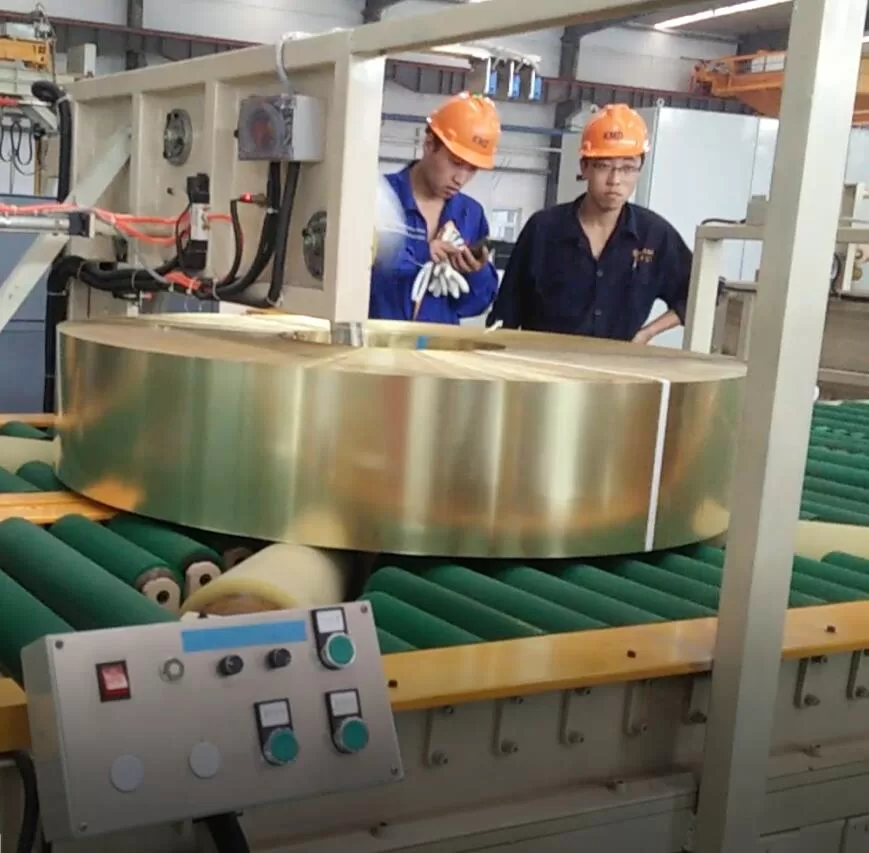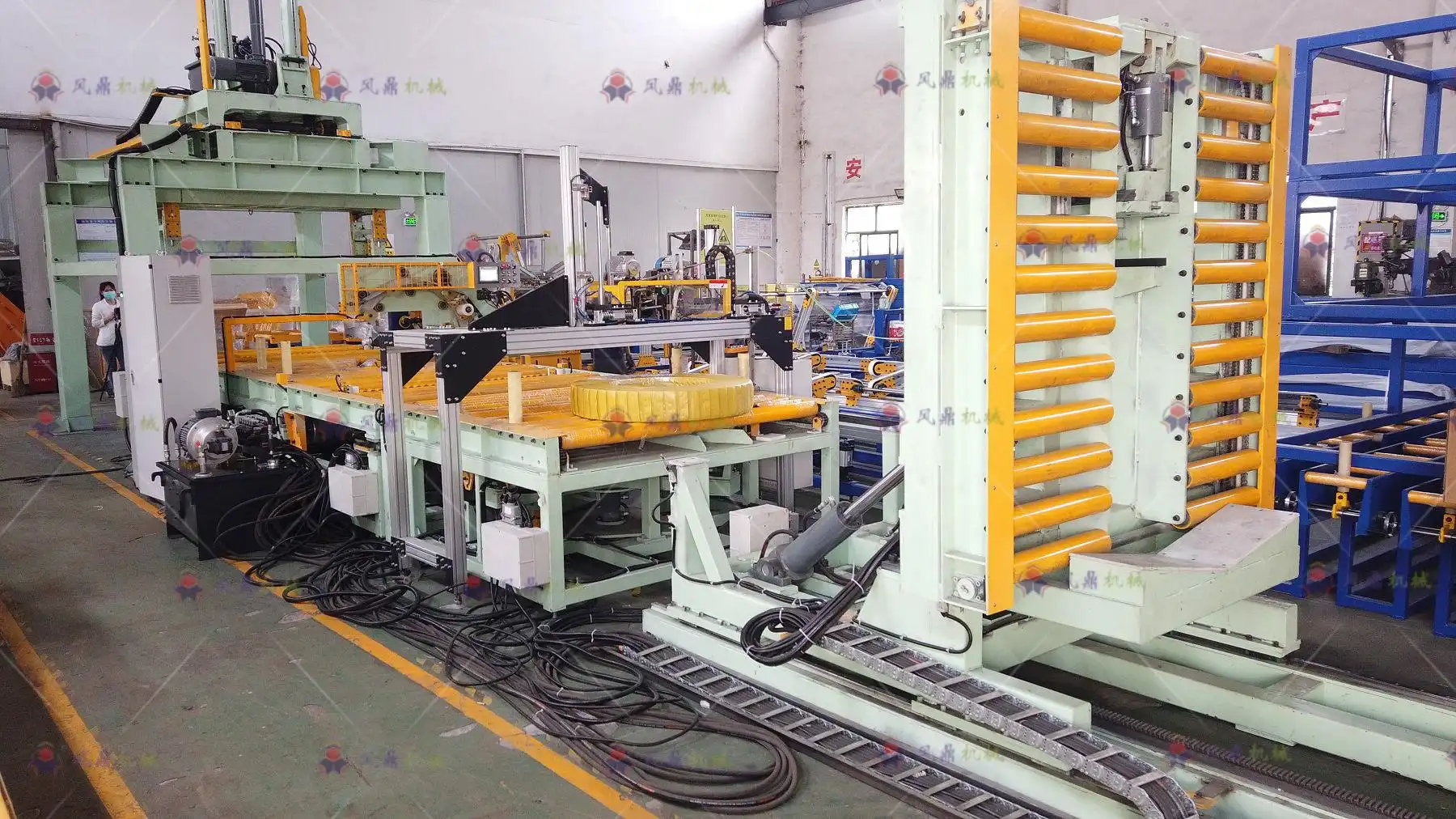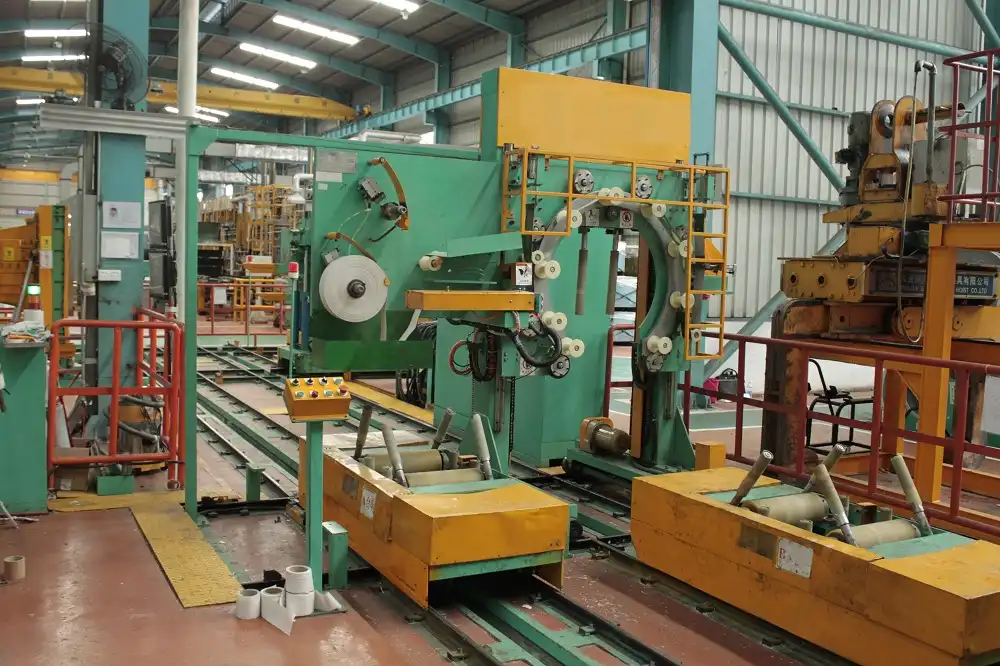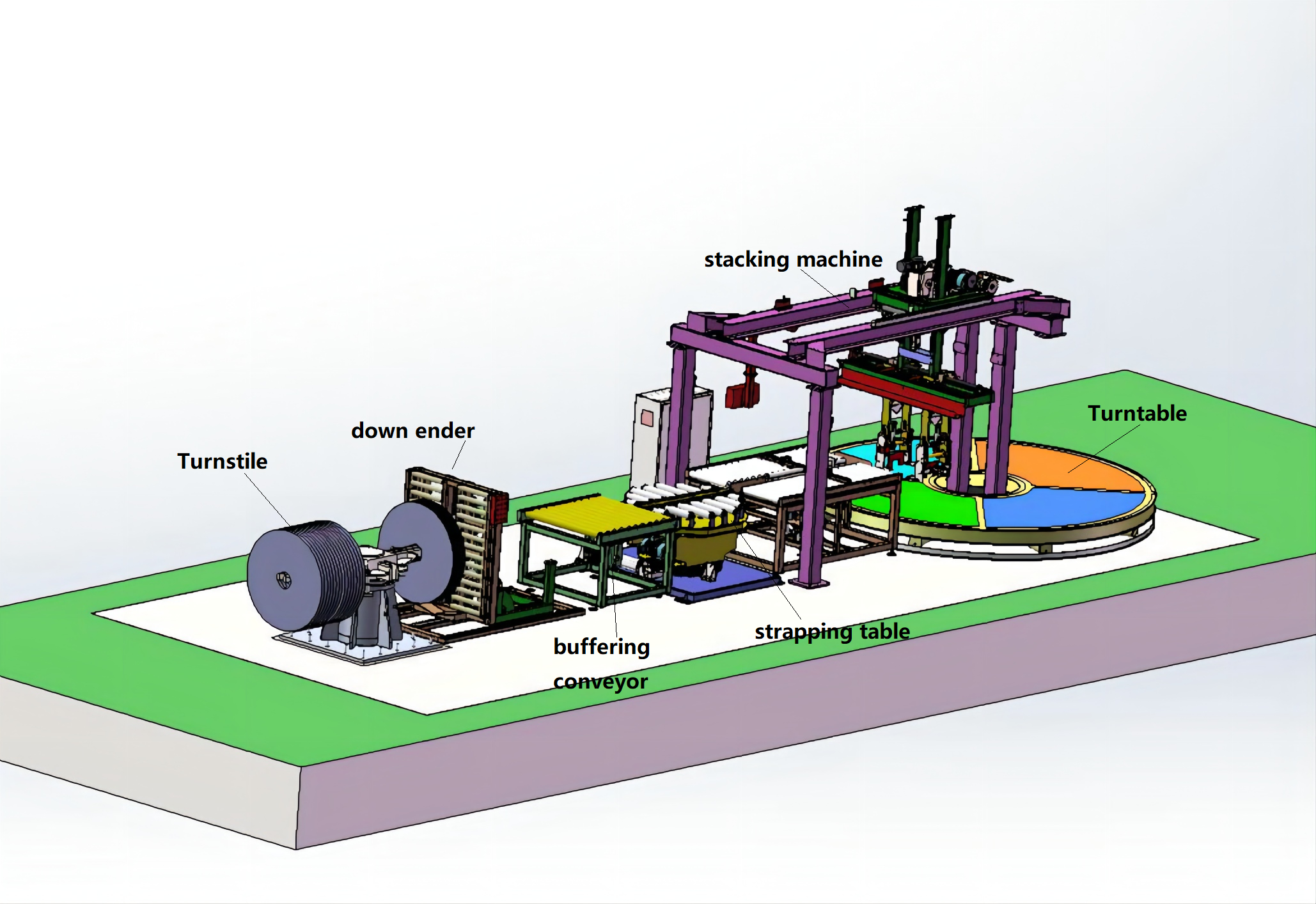The pressure on American steel plants is immense. From Texas to Ohio, mill owners I speak with share the same stories. They face volatile energy costs that can destroy a quarter's profits. Their trusted, hardworking equipment is now over 15 years old, leading to more frequent and costly breakdowns. On top of that, new environmental regulations and fluctuating market demands create a constant state of uncertainty. It feels like a battle fought on multiple fronts, where every decision is critical and the margin for error is shrinking. You're trying to grow and modernize, but you're spending too much time and money just keeping the old machinery running.
Coil packing lines are powering American steel plants by transforming the final stage of production from a costly bottleneck into a source of efficiency and data. These modern systems replace aging, labor-intensive equipment with fully automated solutions that increase throughput, protect coil quality, drastically cut operational costs, and integrate seamlessly with plant-wide digital systems. This provides the reliability and intelligence needed to compete in today's challenging market.

I've been an engineer my whole life. I started on the factory floor and eventually built my own company. I understand that when you're running a massive operation like a steel mill, you don't just look at a single machine. You look at the entire process. You ask tough questions. You need to see a clear return on investment. The final packing line is often overlooked, but I want to show you how a modern system can provide clear answers to some of your biggest challenges. Let's break down the questions that leaders like you are asking.
How can a modern coil packing line solve the problems of aging equipment in American steel plants?
You have a packing line that's been a workhorse for 15, maybe 20 years. But now, it’s becoming a major headache. Finding spare parts feels like a treasure hunt. Unplanned downtime is happening more often, and each time it does, it sends ripples of disruption back through your entire production schedule. You worry that a critical failure is just a matter of time, potentially jeopardizing a major customer order and damaging your reputation.
A modern coil packing line directly solves these problems by replacing uncertainty with reliability. It is engineered with superior, globally recognized components, advanced diagnostics, and modular designs. This means maintenance becomes predictable and repairs are faster. It transforms a constant point of failure into a dependable asset that strengthens your entire operation.

Moving from Reactive Fixes to Proactive Control
The core difference between old and new equipment is the shift from a reactive to a proactive mindset. For years, the approach to maintenance was "if it breaks, fix it." This is an incredibly expensive way to operate. A modern line is designed to tell you about a problem before it happens. This is a fundamental change that directly impacts your plant's uptime and profitability.
Here's how this is achieved in a tangible way:
-
Standardized, High-Quality Components: Older machines often used proprietary parts that are now obsolete. I remember a client in Indiana who had a line from the 90s. A single gearbox failed, and the original manufacturer was out of business. They faced a 16-week lead time for a custom replacement. Our modern lines are built with components from world-class brands like Siemens, SEW, or Allen-Bradley. This means spare parts are readily available anywhere in the world, often with next-day delivery. This simple design choice eliminates a huge risk from your operation.
-
Predictive Maintenance through IoT: We embed sensors throughout the line to monitor the health of critical components. These sensors track motor temperature, bearing vibration, hydraulic pressure, and electrical current. This data is constantly analyzed. Instead of a sudden breakdown, your control system sends an alert: "Warning: Motor 7 on the wrapping station shows increased vibration by 12%. Expected lifecycle: 150 hours. Please schedule inspection." This allows your team to schedule maintenance during a planned shutdown, turning a crisis into a routine task.
-
Modular Design for Fast Repairs: Many old lines were welded together as one monolithic unit. Servicing one part often required disassembling a huge section of the machine. Today, we build in modules. The wrapping station, the strapping unit, the conveyor sections—they are all distinct modules. If one section needs major service, it can be repaired or even swapped out far more quickly, dramatically reducing the Mean Time To Repair (MTTR).
Here is a simple comparison that illustrates the financial and operational impact:
| Feature | Aging Equipment (15+ Years) | Modern SHJLPACK Line | Impact on a Steel Plant |
|---|---|---|---|
| Maintenance Strategy | Reactive (Fix after failure) | Proactive (Predict & prevent) | Drastically reduces unplanned downtime. |
| Spare Part Availability | Low (Obsolete, custom parts) | High (Standardized, global brands) | Minimizes repair time from weeks to hours. |
| System Diagnostics | Basic fault lights | Detailed on-screen alerts, remote access | Maintenance team can identify the root cause in minutes, not hours. |
| Mean Time Between Failures (MTBF) | Decreasing | High and stable | Increases overall production reliability. |
By addressing these core engineering principles, a new line isn't just a replacement. It's a strategic upgrade that brings predictability and stability back to your plant floor.
You look at your monthly operational expenses, and the numbers are daunting. Electricity and fuel prices swing wildly, making budget forecasting a nightmare. At the same time, labor costs continue to climb. You have an ambitious goal to reduce overall operating costs by 8%, but every line item seems to be working against you. It's a high-stakes balancing act to maintain quality and safety while aggressively managing every dollar.
A modern packing line can become a powerful tool in your cost-cutting arsenal. It is engineered with specific features that target two of your biggest expenses: energy and labor. Through high-efficiency motors, intelligent power management, and full automation, the line directly attacks these costs. It helps you find significant savings in an area you may not have previously considered.

Unlocking Hidden Savings at the End of the Line
The savings potential in a modern packing line is not just theoretical; it's built into the design of the machine. When we design a line, we are obsessed with efficiency, because we know that is what our clients value most. The savings come from a combination of smart technology and optimized processes. Let's break it down into the key areas where you will see a direct impact on your bottom line.
1. Energy Consumption Savings:
An old packing line is often an energy hog. Its motors run at full speed whether they need to or not, and it consumes significant power even when idle. A modern line is much smarter.
- Variable Frequency Drives (VFDs): This is one of the most important features. On large motors, like those driving the main wrapper or conveyors, we install VFDs. A VFD adjusts the motor's speed and torque to precisely match the load requirement. Instead of running at 100% power to move a light coil, it might only use 40% power. This alone can cut the energy consumption of those motors by 20-50%.
- Intelligent "Sleep Mode": In a typical plant, there can be gaps between coils. An old line would sit there, with all motors, heaters, and hydraulic pumps running and drawing power. A modern line detects when it has been idle for a set period (say, 3 minutes) and automatically enters a low-power "sleep mode." It powers down all non-essential components and then instantly wakes up when the next coil is detected. This eliminates wasted energy during production gaps.
2. Labor and Material Cost Reduction:
Direct labor is a huge operational expense. A semi-automatic or manual packing process can require two or even three operators per shift.
- Full Automation: A fully automated line can be managed by a single supervisor who oversees the entire process. The system handles everything: receiving the coil, weighing it, wrapping it, strapping it, and applying the label. Let's do some simple math. If you eliminate two operators per shift across three shifts, that's 6 positions you no longer need in that area. At an average loaded labor cost, that can easily equate to over $300,000 in savings per year.
- Precise Material Usage: Hand-wrapping or older machines are often wasteful. Operators might add extra layers of film "just to be safe." A modern wrapper uses sensors to measure the coil's dimensions and applies the exact, pre-programmed amount of wrapping film and other protective materials. This precision can reduce your consumption of wrapping materials by 10-20%, another significant and direct saving.
Here's a look at the cost impact:
| Cost Center | Aging Equipment | Modern SHJLPACK Line | Annual Impact Example (for a large mill) |
|---|---|---|---|
| Energy (Electricity) | Constant high draw, no idle management | VFDs, sleep modes, efficient motors | $30,000 - $50,000 in savings |
| Direct Labor | 2-3 operators per shift | 1 supervisor per 3 shifts | $300,000+ in savings |
| Wrapping Materials | Inconsistent, often wasteful | Precise, automated application | $20,000 - $40,000 in savings |
These are not small changes. They are substantial, measurable savings that contribute directly to your goal of reducing overall operational costs.
How does a new packing line integrate with digital transformation goals like MES and IoT?
You are making a major investment to create a "smart factory." You're implementing a Manufacturing Execution System (MES) to manage production orders, deploying IoT sensors to collect data, and building a data analytics platform to find new efficiencies. But there's a problem: your old equipment is a "black box." It can't communicate with your new digital systems. This creates a critical blind spot at the very end of your production process, preventing you from achieving the complete, real-time visibility you need.
A modern packing line is designed to be a native citizen of your digital ecosystem. It's not a black box; it's a smart, data-rich hub. Using open communication protocols and intelligent controls, it speaks the same language as your MES and other platforms. It acts as a vital data source, closing the information loop and giving you a truly complete picture of your entire production flow from start to finish.

Making the Packing Line a Smart Data Hub
In the era of Industry 4.0, a machine's value is not just in what it does physically, but also in the data it can provide. Your packing line is the final checkpoint for every coil that leaves your plant. The data it generates is incredibly valuable for production, quality, and maintenance. A modern line is designed to seamlessly integrate and share this information.
The integration works in two directions:
1. Data Flow TO the Packing Line (Instructions from the MES):
Without integration, an operator has to manually enter information for each coil—a slow process that is prone to human error. With integration, the process is automated and error-proof.
- When a coil arrives at the packing line, its ID is scanned.
- The packing line's PLC (Programmable Logic Controller) instantly communicates with your MES.
- The MES sends back a complete "packing recipe" for that specific coil ID. This includes:
- Customer-specific wrapping requirements (e.g., VCI paper plus stretch film).
- The exact strapping pattern needed (e.g., 4 radial straps, 2 eye straps).
- The precise information to print on the label (Coil ID, weight, grade, customer name).
This automated handshake ensures that every coil is packed exactly to specification without any manual intervention, increasing quality and throughput.
2. Data Flow FROM the Packing Line (Information to your Systems):
This is where you gain true visibility. The packing line becomes a rich source of real-time data that feeds your MES, SCADA, and data analytics platforms.
- Production Data: It reports the start time and end time for each packing cycle, the total number of coils packed per shift, and any downtime events. This data is crucial for calculating Overall Equipment Effectiveness (OEE) and identifying bottlenecks.
- Material Consumption Data: The line tracks exactly how much stretch film, paper, and strapping was used for each coil. This allows for precise inventory management and cost accounting.
- Quality Control Data: The integrated scale records the final shipping weight of the coil and logs it against the coil ID, creating a permanent quality record.
- Maintenance Data: As mentioned before, it sends alerts from its predictive maintenance sensors. It also logs every fault code, helping your maintenance team quickly diagnose and resolve issues.
Think of it this way: an old packing line is like an employee who does their job but never files a report. A modern, integrated packing line is like your star employee who not only does the job perfectly but also provides a detailed, data-backed report on their performance, helping the entire company improve. This integration is no longer a luxury; it is essential for achieving the level of data-driven optimization required to lead in the modern steel industry.
What makes a supplier a true strategic partner, not just an equipment seller?
You've likely had this experience: a supplier is very attentive during the sales process, but after the machine is installed and the final payment is made, they become hard to reach. When you have a problem, you get passed around customer service. They sold you a piece of equipment, but they didn't provide a complete solution. This leaves your team struggling to optimize the machine and manage its long-term health. You're not looking to repeat that experience. You need a partner who is as invested in your long-term success as you are.
A true strategic partner views the sale as the beginning of a long-term relationship, not the end of a transaction. They provide comprehensive, end-to-end support that covers the entire lifecycle of the equipment. They act as an extension of your own engineering team, offering proactive advice, sharing deep industry expertise, and committing to helping you achieve your strategic goals, like improving safety, meeting environmental standards, and maximizing your return on investment.

The SHJLPACK Philosophy: Your Success is Our Success
This question is personal to me because it is the foundation of my company, SHJLPACK. When I started my journey as an engineer on the factory floor, I saw the gap between what equipment sellers promised and what they delivered. When I founded my own factory, I vowed to do it differently. For us, a partnership is not a marketing slogan; it is our operational model. It’s built on shared knowledge and a deep commitment to solving our clients’ real-world problems.
Here is what that partnership looks like in practice, from our first conversation to years after your line is installed:
1. Deep Consultation, Not a Sales Pitch: Our first step is to listen. We want to understand your specific challenges. We'll ask about your coil sizes, your plant layout, your production targets, and your frustrations with your current process. We analyze your unique situation. I once spent a week at a plant in Texas just observing their workflow before we even proposed a design. We don't have a one-size-fits-all solution. We design a line that is tailored to solve your problems and meet your goals.
2. Transparent Manufacturing and Factory Acceptance Test (FAT): We believe in complete transparency. We invite your team to our facility during the manufacturing process. Before the equipment ever leaves our factory, you will participate in the Factory Acceptance Test (FAT). You will see your machine, running with your coil types, and can verify its performance and quality with your own eyes. This critical step builds trust and ensures there are no surprises during installation.
3. On-Site Installation and Training: Our partnership continues on your plant floor. Our experienced engineers don't just supervise the installation; they work alongside your team. We are not finished until the line is fully commissioned and running smoothly within your production environment. Crucially, we provide comprehensive training for your operators and maintenance staff. We want your team to feel confident and capable of managing the equipment effectively.
4. Proactive Long-Term Support and Advice: Our relationship grows stronger over time. We provide ongoing support through remote diagnostics, where we can log into your system (with your permission) to help troubleshoot issues in real time. We also provide strategic advice. When new environmental standards are announced, we can proactively reach out with recommendations for how your packing line can help you comply. When new technologies emerge, we share that knowledge with you. We want to be the first call you make when you have a question about anything related to coil packing and handling. This is the essence of our slogan: "TOTAL SOLUTION FOR WRAPPING MACHINE."
My Insights
Reading about a leader like Javier Morales, who started in the steel industry and worked his way up to become the owner of his own mill, reminds me so much of my own journey. We both started by getting our hands dirty on the factory floor. We learned the business not from a textbook, but from the hum of the machinery, the heat of the process, and the daily challenge of making things work right.
When you have walked that path, you see the world differently. You understand that when you invest in a new piece of equipment, you are not just buying steel and motors. You are investing in stability for your business. You are investing in the safety of your employees. You are making a promise to your customers that you can deliver a quality product on time, every time. The weight of those decisions rests on your shoulders.
This shared experience is why I believe so strongly in partnership. I achieved my own financial independence because of the opportunities this industry gave me. My clients succeeded, and in turn, I succeeded. Now, my mission with SHJLPACK is to give back. It’s to share the knowledge I’ve gained over decades to help other engineers and business owners solve their toughest problems. A transaction is about exchanging money for a machine. A partnership is about engineers helping engineers, building a foundation of trust, and working together to build a stronger, more efficient, and more profitable future. That is a responsibility I take very seriously.
Conclusion
A modern coil packing line is a strategic investment in efficiency, data, and future-proofing your steel plant’s operations, turning a cost center into a competitive advantage.





